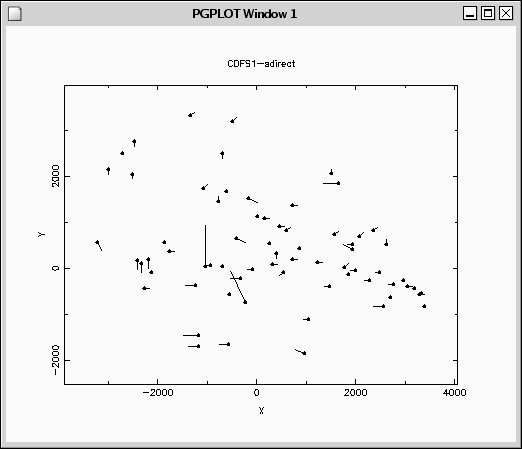align-mask
align-mask
align-mask uses a direct, or dispersed, image of a slitmask to improve on the
(1) scale (2) rotation and (3) x,y offsets values given in an existing dewar
offset file. Output is a new dewar offset file. align-mask predicts the
locations of apertures (or spectral lines) in an image of a mask, using the
observset observation definition file. It searches near each predicted location
for the expected apertures/lines and calculates offsets for each. From the set
of offsets, the program solves for the focal plane scale, rotation angle, and
x,y offsets which will minimize the median errors. Although align-mask can be
used with any image, it is advisable to use either a direct image with well-
spaced apertures, or a dispersed image with well-isolated lines, particularly
if the expected position errors are significant (greater than a few pixels).
HINT: If you wish to iterate on a fit, remember to change the name of the dewar
offset file to framename in the observation definition file after the first
iteration.
| USAGE | align-mask -o observset -f framename
| ||||||||||||||
| INPUT | framename is a set of image files containing a direct or dispersed image of a slitmask observset.obsdef is the name of an existing observation definition file which describes the observing setup used for the frame and specifies an existing dewar offset file
| ||||||||||||||
| OUTPUT | framename.dewoff, a new dewar offset file.
| ||||||||||||||
| PARAMETERS |
|
Details:
When first invoked, align-mask calculates the predicted positions of all the
apertures (or lines), then searches near these positions for the apertures/
lines. Only apertures/lines stronger that threshold x background are included
(a useful value of threshold is a few tenths, if your frame has not had bias
subtracted). If you are using a dispersed (rather than direct) image, align-
mask searches for the images of each spectral line listed in lamfile. If you
expect the initial alignment to be pretty good, start with parameters searchbox
= 10 and magfactor = 100. A plot of the position errors for all apertures found
is first presented:

68 matches found. sigma = 1.95 pixels. Continue?
You should see most of your apertures. If you see very few, chances are that
something is very wrong with the dewar offset file. If you get just points near
the middle, with vectors indicating rotation, your rotation angle is probably
off; proceed as described below to adjust. If there are a few widely scattered
or no points, your x,y offsets may be so far off that the program cannot find
the apertures. Try increasing searchbox to 20, then to 50. If you still can't
find your apertures, you probably either have the wrong mask/SMF file
combination, or the mask is rotated by 90 or 180 degrees or the dewar rotation
is set wrong (Normal vs Nod&Shuffle). If you can't figure it out, try running
apertures (for a direct image) or spectral-lines (for a dispersed image) and
comparing the mask image with expected spot locations. If there are lots of
very long vectors, you may want to quit [answer "n"] and rerun the program with
a smaller magfactor.
If things don't look hopeless, answer "y" and the following dialog will occur:
Average scale = 0.99997 Reset scale?
Normally, the scale only varies by a few parts in 10**4. If scale differs from 1.000 by that much, you may want to say "y". If less, don't bother. If much more, something else is very wrong with the fit. Answer "n" on this iteration and proceed. Next:
Average rotation angle = -0.001 Reset angle?
It should be apparent from the plot if significant rotation is present. Unless the number seems wildly inconsistent with what your eyes tell you, answer "y". Don't bother if the angle is less than a few thousandths of a degree.
Average X,Y Offsets = 0.2 -0.1 pixels Apply shifts?
Normally, answer "y" unless the offsets are 0.1 pixel or less.
Now, set the name of the dewar offset file in the obsdef file to that produced
by this iteration of align-mask, and run the program again. If you had
increased searchbox significantly above 20, or decreased magfactor much below
100, you may want to change them again. Your final sigma should at most be a
few pixels unless there is a problem with the mask or setup.
Notes
- There is a limit to the number of slit images that can be handled. If you are using a dispersed image with very many slits, pick a small number of isolated comparison lines.
- The parameter
navershould normally be set to 1, except for unusual cases of very noisy data.
